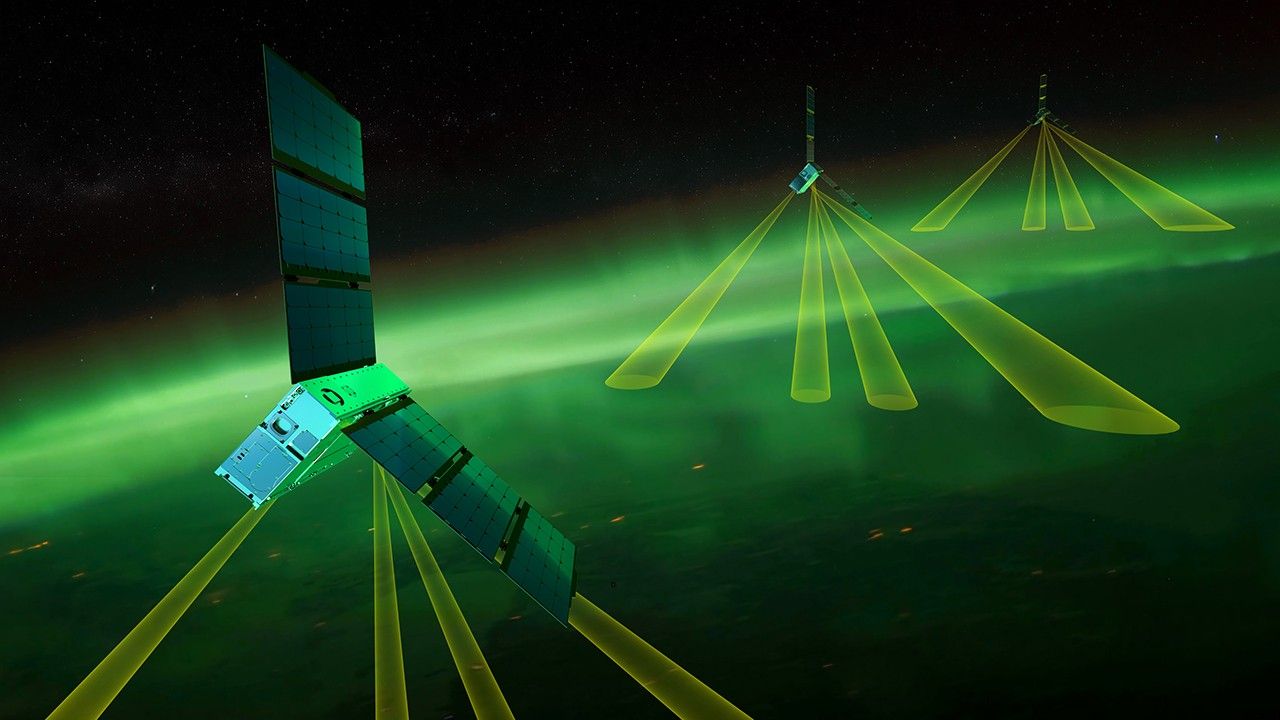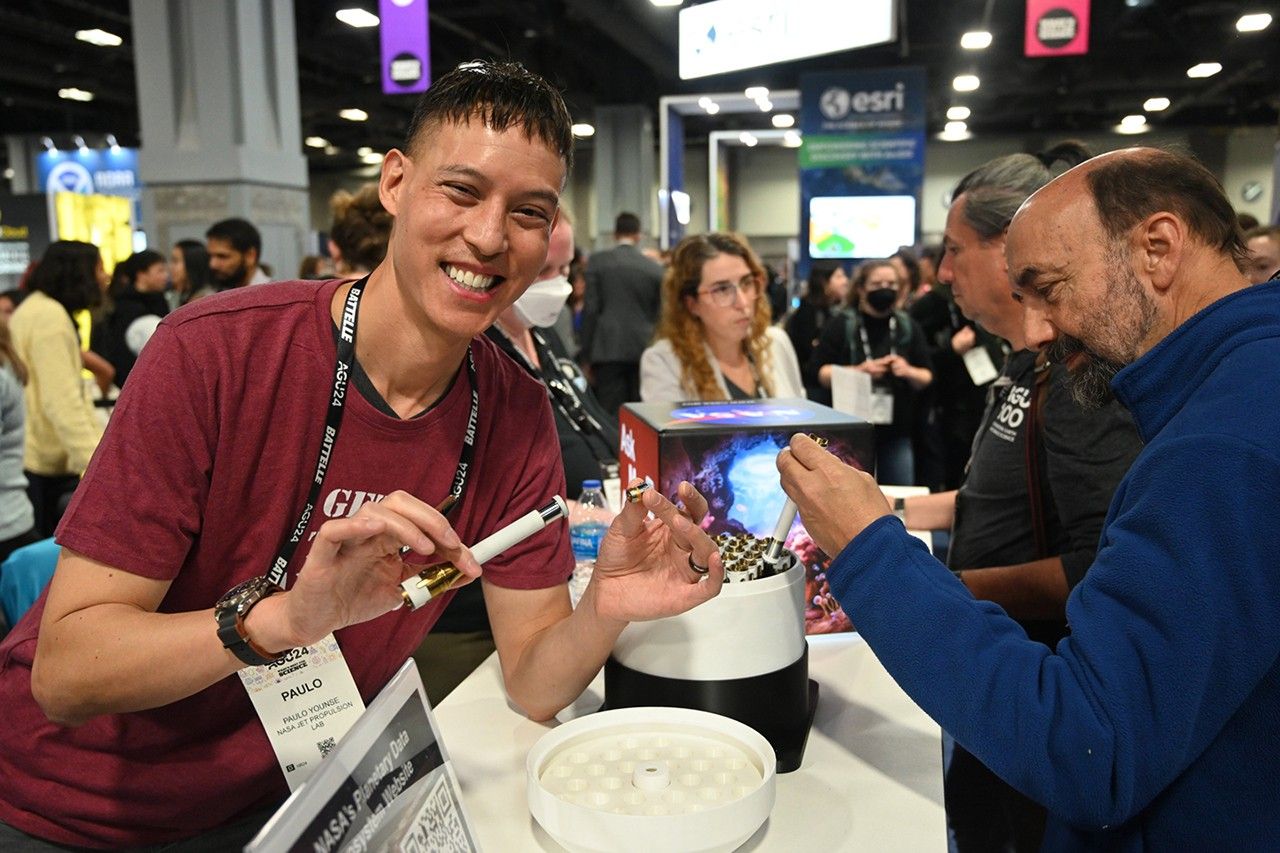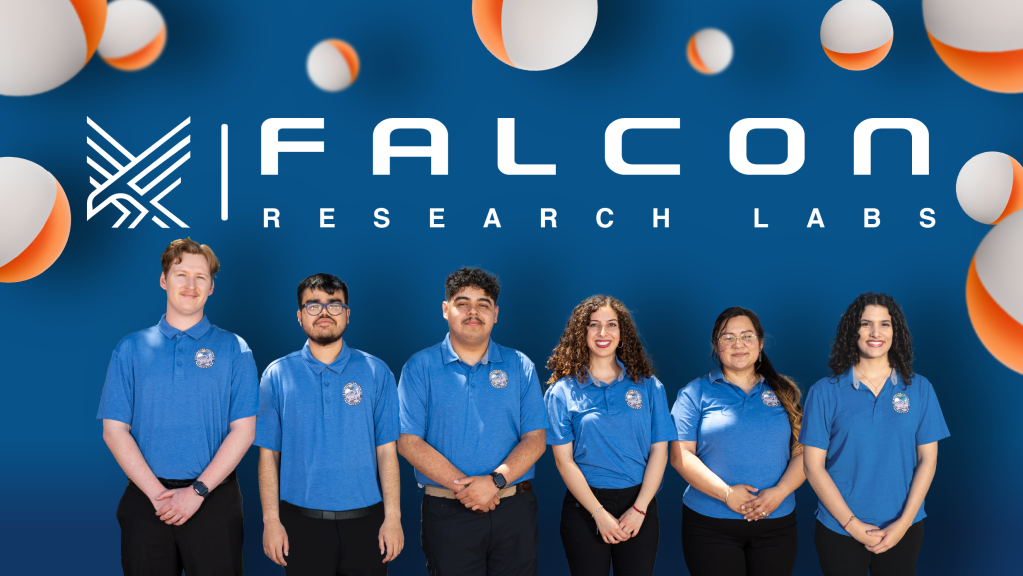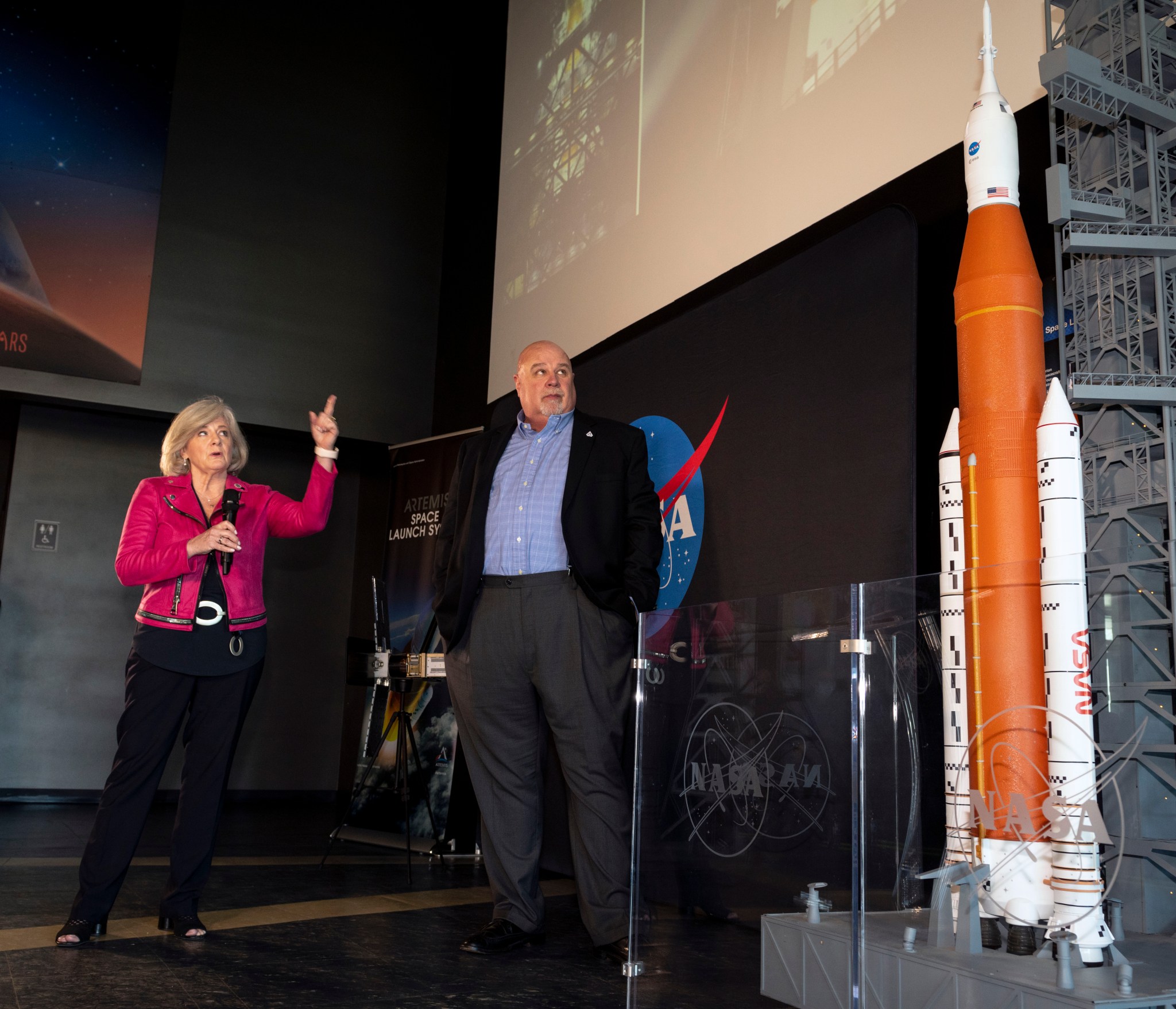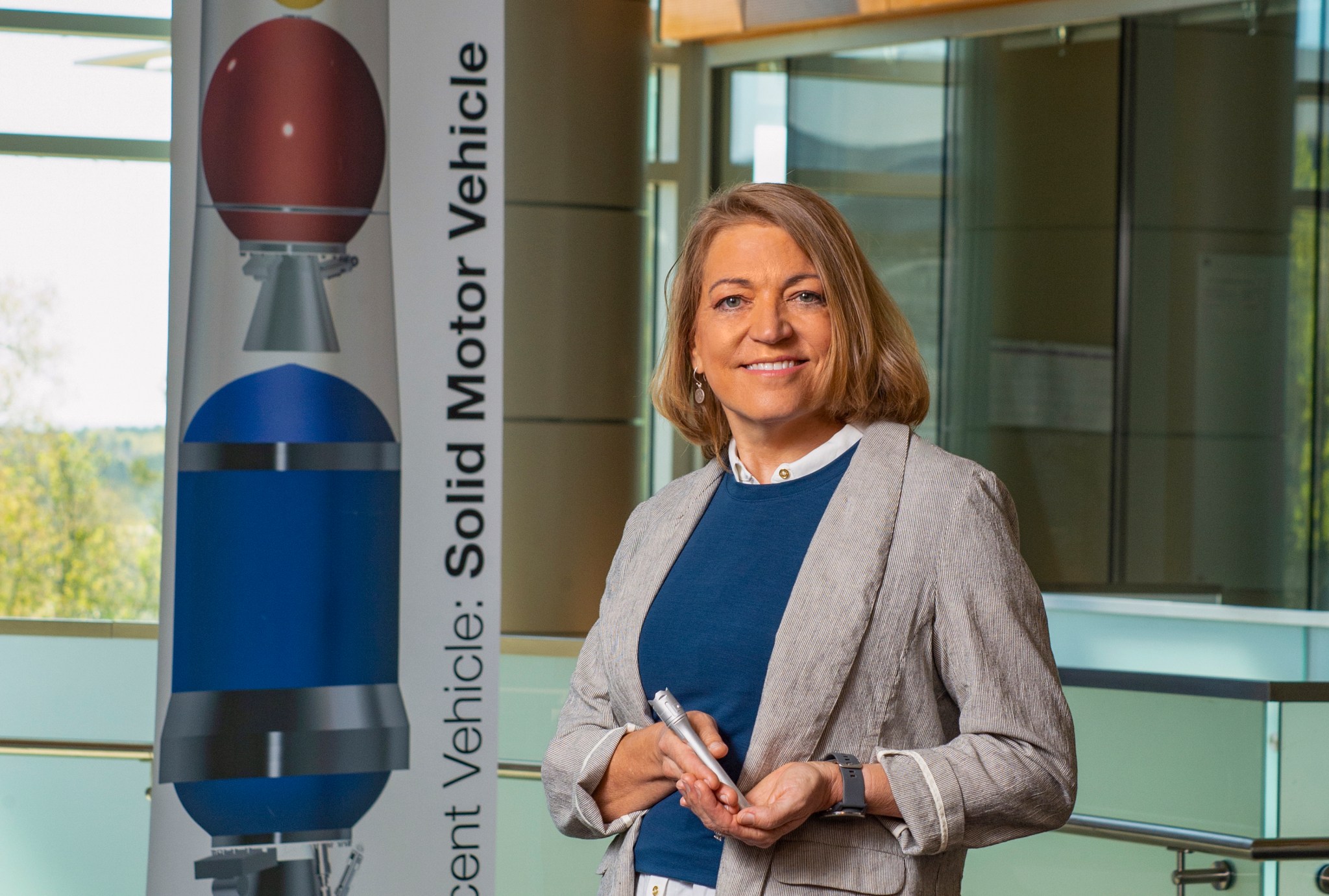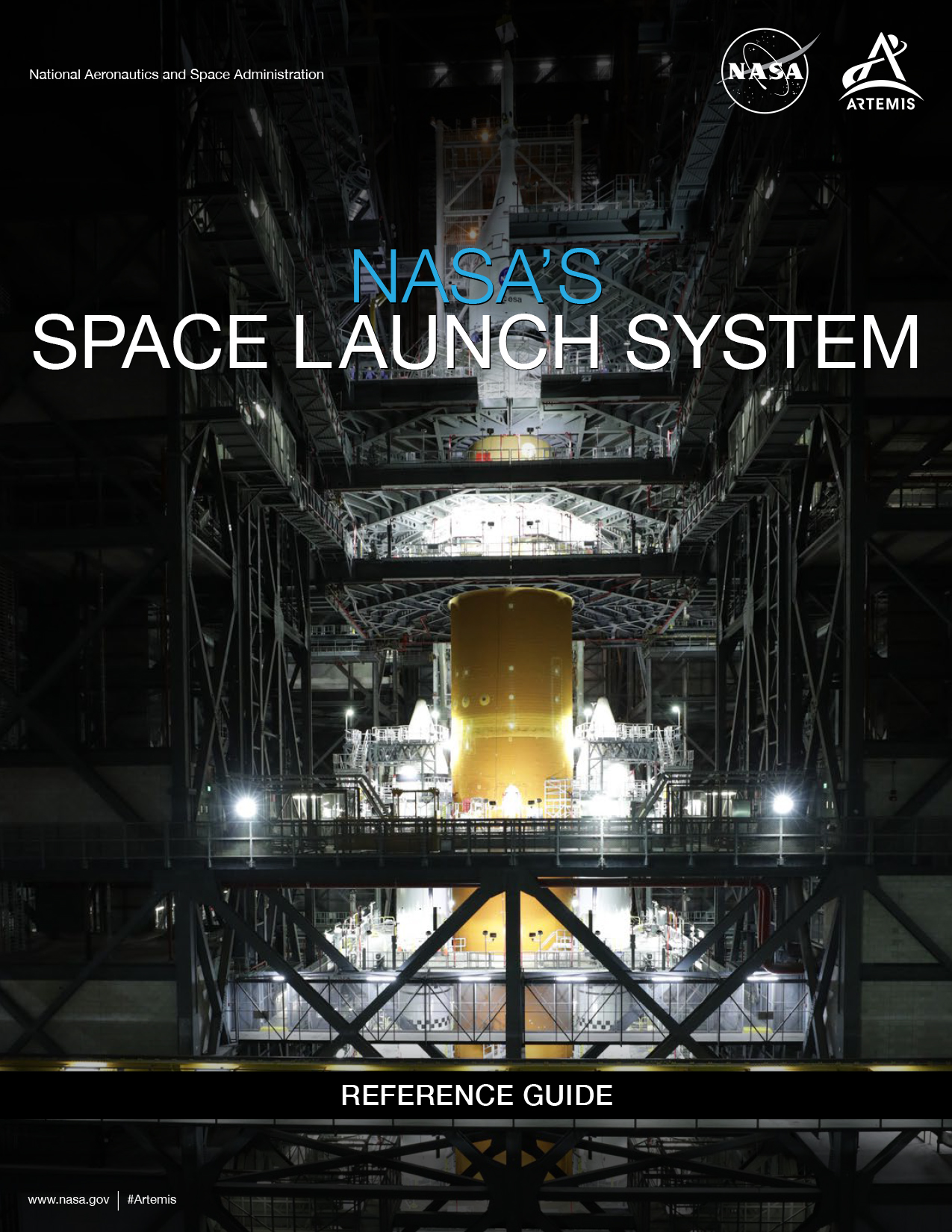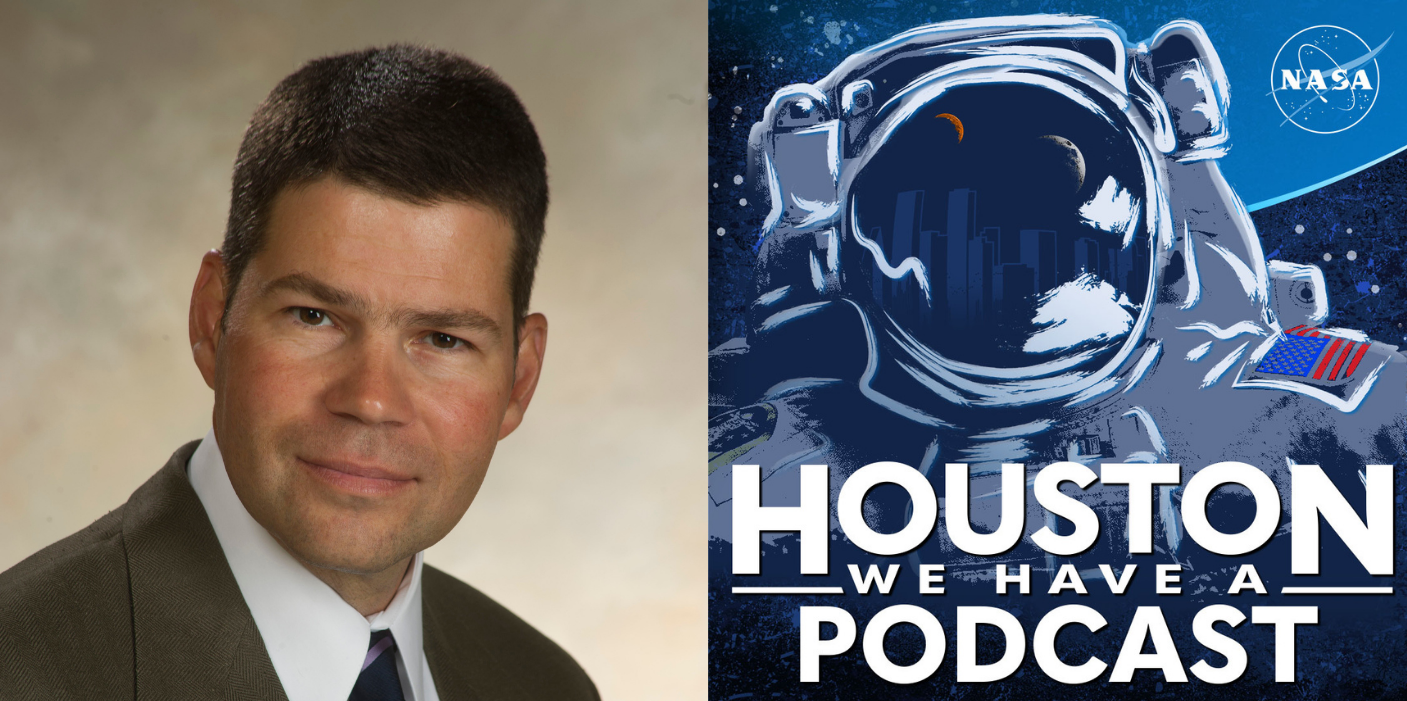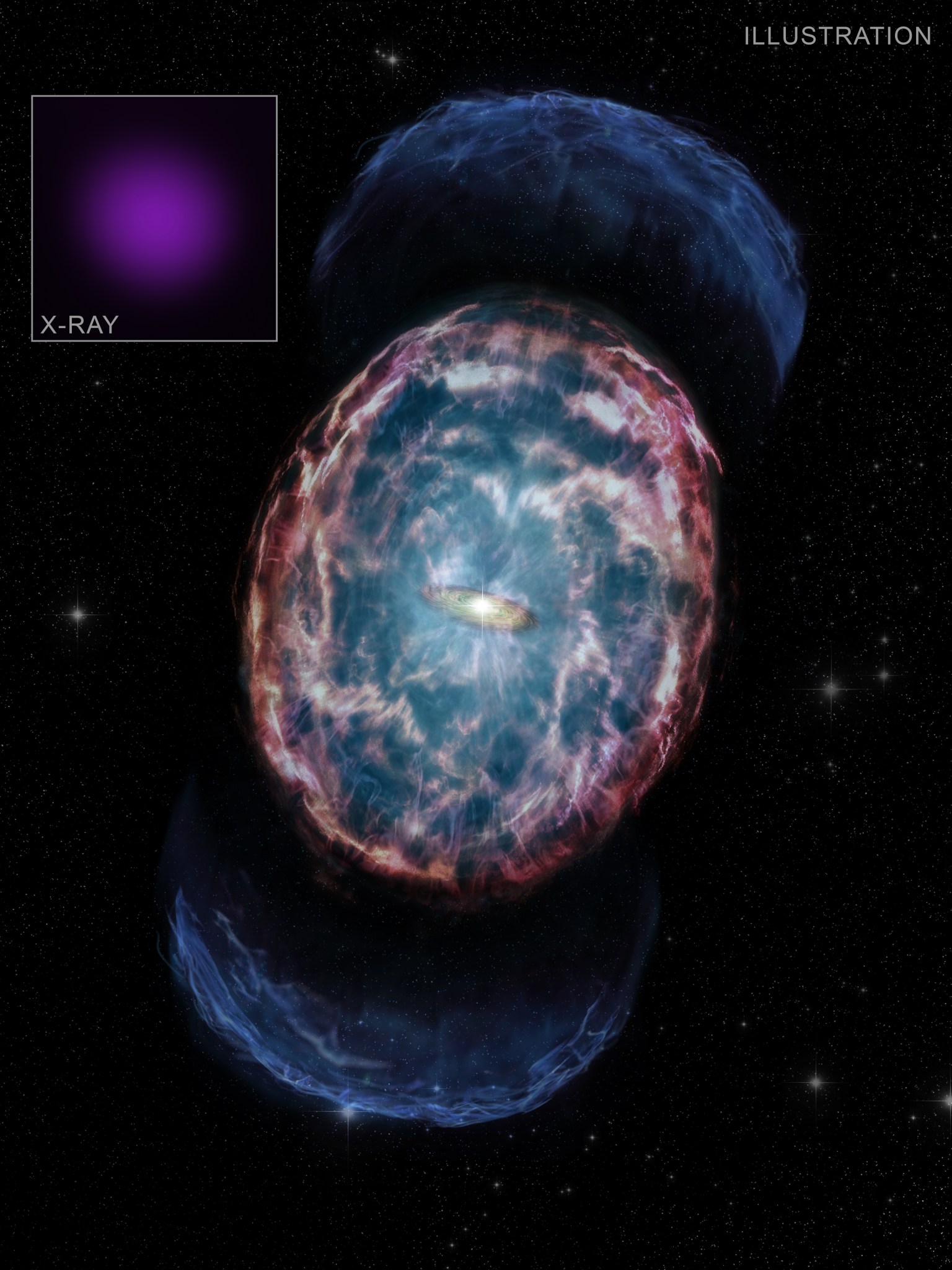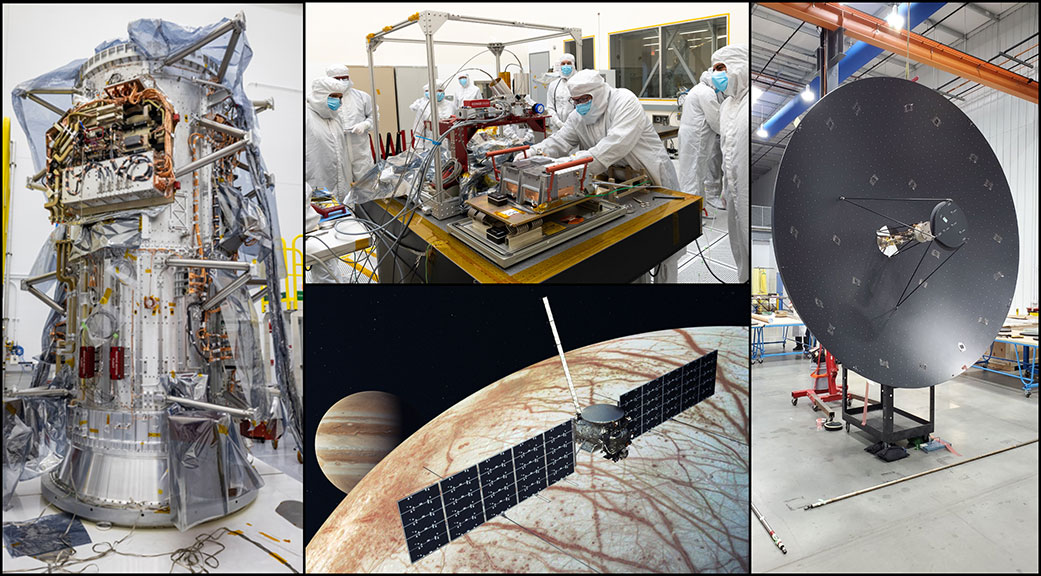Marshall Leadership Confident as Artemis I Preparations Continue
By Wayne Smith
As launch day nears for Artemis I, leaders at NASA’s Marshall Space Flight Center remain confident in laying the foundation for the next generation of space exploration.
Marshall Director Jody Singer and other center leaders met with media members March 4 during Artemis Media Day at Building 4205 to discuss the upcoming launch and all the work Marshall is doing for NASA’s future Artemis missions. Subject matter experts from across Marshall also discussed how their organizations are supporting Artemis with everything from advanced life support systems to cutting edge technology development.
Singer expressed her confidence in the team working on the Artemis missions to “rewrite the next chapter of history.” She said Marshall is ready to continue leading the way in space exploration.
“Everything we do here, from Artemis work to science to technology development, is because we have a determined team of people making it happen,” Singer said. “All the things you have to live, work, breathe, and design, that’s where Marshall Space Flight Center will continue to be a critical part in making it happen.”
The Artemis I launch of the Space Launch System rocket and Orion spacecraft is planned for May, with the agency also looking at June, from Kennedy Space Center. Initial rollout for wet dress rehearsal for the SLS and Artemis 1 mission is scheduled for March 17.
“We are now focused on rolling out to the pad and successfully completing multiple tests, including the wet dress rehearsal,” said John Honeycutt, program manager of the SLS rocket at Marshall. “I’m tremendously confident – and our confidence level will only go up based on what we learn from the tests.”
Once the wet dress rehearsal is complete, the rocket will roll back into the Vehicle Assembly Building at Kennedy for final preparations before returning to the launch pad. Singer said engineers will examine the hardware and learn from going through the rehearsal.
“We test to understand this vehicle before we put humans on it, before we take that first flight,” Singer said. “We want to make sure we identify any issues; we fix them and then we’re ready to fly. The wet dress is very critical toward being able to set a true launch date and our readiness to be able to roll back to the pad.”
Singer and Honeycutt discussed Marshall contributions toward the first Artemis launch, including building and designing the SLS rocket. Michoud Assembly Facility Deputy Director Hansel Gill discussed the facility’s role in manufacturing and assembling critical hardware components for the rocket.
Other Marshall leaders briefed media members on leading out the sail development for NEA Scout, contributing to Orion including the Launch Abort System, and secondary CubeSat payloads. Tours highlighted Marshall work in nuclear thermal propulsion and the SLS Avionics Lab. Marshall will also contribute to future Artemis missions with the Human Landing System Program and engineering support.
Through the Artemis Generation, NASA will land the first woman and first person of color on the Moon, using innovative technologies to explore more of the lunar surface than ever before. The agency plans to collaborate with commercial and international partners and establish the first long-term presence on the Moon. From there, NASA will use what it learns on and around the Moon to take the next giant leap: sending the first astronauts to Mars.
Smith, a Media Fusion employee, supports Marshall’s Office of Strategic Analysis & Communications.
Angie Jackman Works to Develop Rocket That Will Bring Mars Samples to Earth
By Rick Smith
Right now, some 188 million miles separate the red clay of Alabama from the dusty red surface of planet Mars. But groundbreaking flight hardware developed at NASA’s Marshall Space Flight Center will soon close that distance.
The new hardware is an integral component of the Mars Sample Return campaign, a historic endeavor that will, for the first time, retrieve and deliver samples of that faraway alien terrain for intensive study in laboratories on Earth. A strategic partnership of NASA and the European Space Agency, Mars Sample Return also will bring us closer to human exploration missions to Mars.
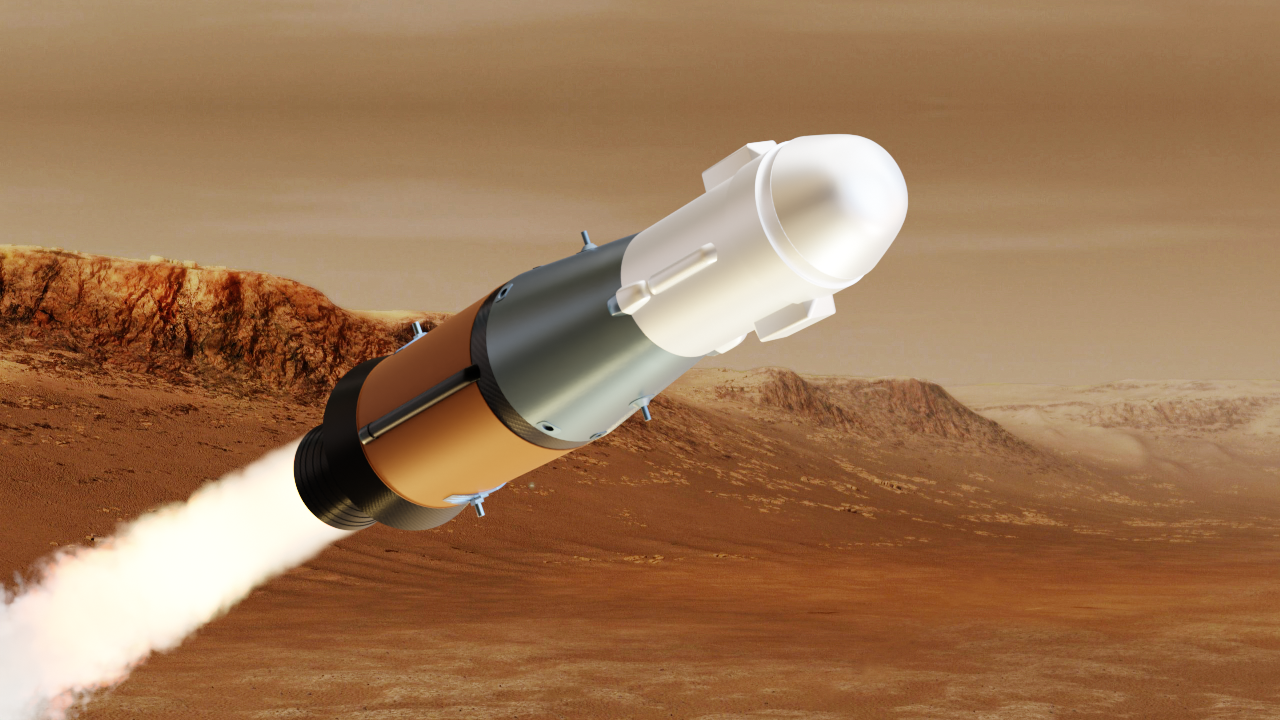
Angie Jackman – who has spent more than 35 years leading some of the agency’s most advanced propulsion and engineering projects, state-of-the-art rocket development programs, and complex space science missions – is the Mars Ascent Vehicle project manager at Marshall.
Set to be the first rocket to launch from the surface of another planet, the vehicle will play a key role in the Mars Sample Return mission, launching to Mars orbit the samples gathered by the Perseverance rover from the ancient crater floor it’s now exploring. The samples will be transferred in orbit over Mars to ESA’s Earth Return Orbiter.
Jackman’s team includes structural, thermal, mechanical, systems, and propulsion engineers, as well as analysts and technologists – a diverse team of Marshall and NASA veterans alongside innovative newcomers – all of them deeply familiar with the vital intersection between flight hardware and scientific progress.
“Ask any engineer on the team, and they’ll tell you the science fascinates them,” Jackman said. “Engineers ask ‘How?’ Scientists ask ‘Why?’ Ultimately, that deeper imperative drives us all – the pride in helping to advance our collective knowledge, to increase our ability to safely navigate our world, and to better understand our place in the cosmos.”
The Marshall team is partnering with Lockheed Martin Space of Littleton, Colorado, which is building the integrated Mars Ascent Vehicle system and designing and developing the rocket’s ground support equipment, and Northrop Grumman Systems Corporation of Elkton, Maryland, which leads development of the ascent vehicle’s propulsion system.
“Together we are working to transform the Mars Ascent Vehicle from a drawing-board concept to an executable project,” Jackman said. “We went through exhaustive design iterations to reduce vehicle mass, ensure automated launch capability, and accurately achieve the orbit necessary to rendezvous with the Earth Return Orbiter and transfer samples for flight back to Earth.”
Combining launch vehicle reliability with the lightweight mass and storage requirements of a complex science payload taps strengths NASA has exhibited across numerous past science and exploration missions. Marshall has solved complex, technical spaceflight challenges for more than 60 years, from the groundbreaking Apollo missions and the space shuttle program to NASA’s Space Launch System, the powerful new rocket set to launch missions that will bring the first woman and first person of color to the Moon.
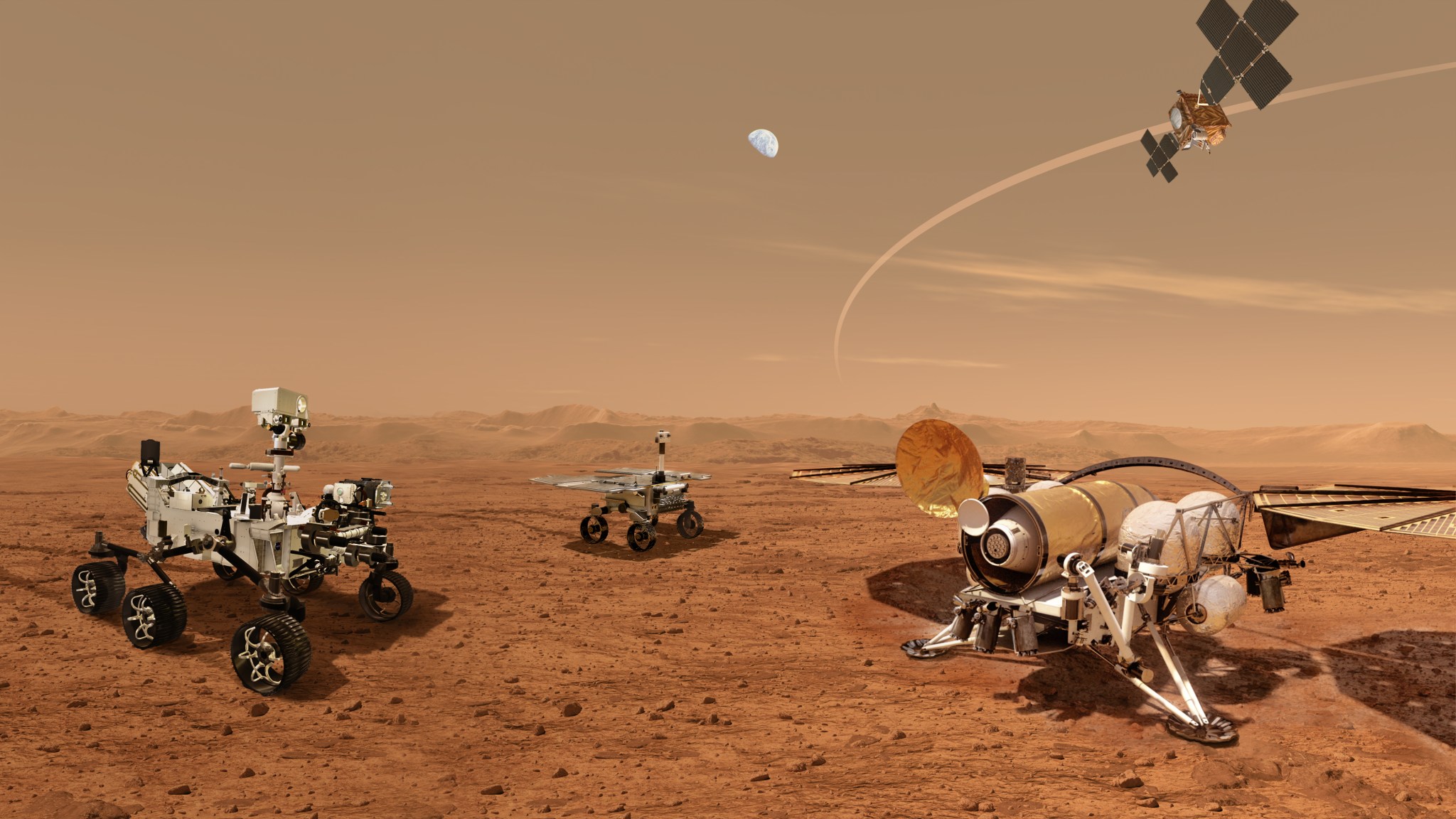
Like most career aerospace managers, Jackman gleans best practices from decades of NASA precedents and lessons learned, but always challenges her team to push against conventional wisdom, to seek fresh alternatives that transcend traditional thinking.
“In this competitive, cost-conscious era, we have to work smarter, faster, and more efficiently,” she said. “Anybody can build a big, sturdy bridge, but it takes a disciplined engineering team to build one on schedule and precisely strong enough to do the job. This project taps every aspect of Marshall’s expertise in propulsion, spaceflight systems, and science. I am so proud of our team. We got this.”
NASA’s Mars Sample Return mission will revolutionize understanding of the Red Planet by returning samples for study using the most sophisticated instruments around the world. These samples are thought to be the best opportunity to reveal Mars’ early evolution and potential for life. The mission will fulfill a solar system exploration goal as identified by the National Academy of Sciences.
Smith, a Manufacturing Technical Solutions employee, supports Marshall’s Office of Strategic Analysis & Communications.
Marshall Women Engineering NASA’s Return to the Moon
By Wayne Smith
In honor of Women’s History Month, NASA celebrates the many contributions women have made to the nation, world, and beyond, including five women at Marshall Space Flight Center who developed flight software that will control the rocket for Artemis missions to the Moon.
These engineers developed and tested Space Launch System software that will tell the rocket how to operate for the first eight minutes of the Artemis I mission during its launch and ascent to orbit. Their work continues Marshall’s legacy of propelling NASA exploration through engineering.
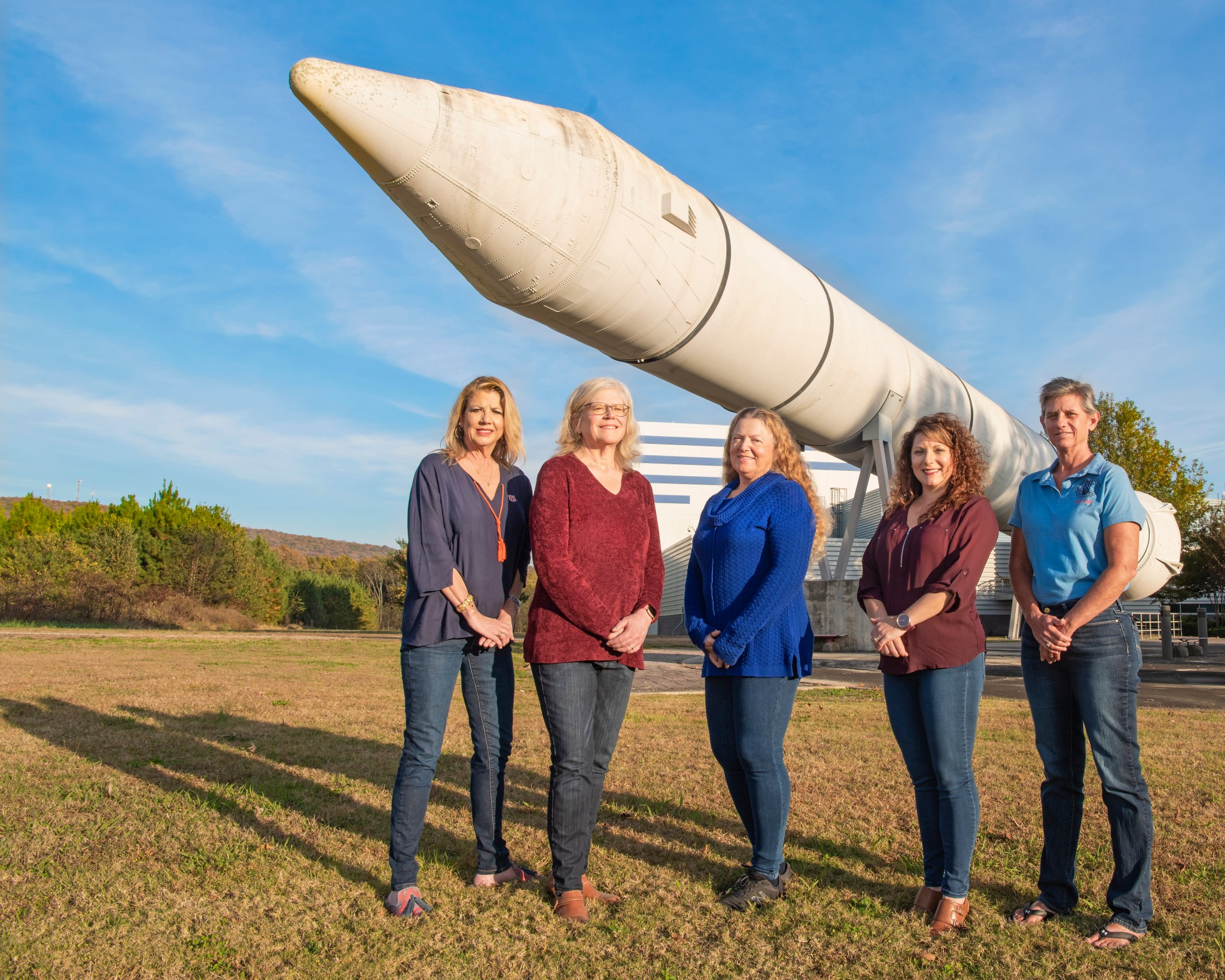
The engineers include Linda Brewster, Avionics and Software Test Facility branch chief; Shawna Broussard, an engineer who also works in the avionics test facility; Shaun Phillips, SLS flight software project lead; Marlyn Terek, Software Development branch chief and former flight software design team lead; and Deanna Whitehead, Flight and Ground Software and Simulation Division chief.
Under Artemis, NASA will land the first woman and first person of color on the Moon, establishing a long-term human presence. The agency will also use innovative technologies to explore more of the lunar surface than ever before and prepare to send astronauts to Mars.
Brewster manages the Integrated Avionics Test Facility where thousands of simulated SLS flights have been flown to test the flight software along with the avionics and flight computers that are critical to launch success. She remembers watching Apollo flights as a child and NASA landing men on the Moon and welcomes the opportunity to work on a mission that will return NASA to the Moon, laying the foundation for future missions to Mars.
“Being a part of the SLS mission and landing the first woman on the Moon is a childhood dream come true,” Brewster said.
The team implemented and tested required capabilities for the software. The software’s development and testing included the successful Green Run test of SLS in March 2021. Each test enables the engineers to learn more about the system and what modifications are needed. Testing has verified more than 1,000 requirements for the system.
Once testing and any needed modifications are completed, the software is loaded on the rocket’s computers, with the flight software team actively supporting integration and testing. Three flight computers will control the rocket from before launch through core stage disposal.
Getting the SLS off the ground involves many steps. Marshall’s integrated avionics test facility has enabled early integration not only across the avionics hardware and the flight software, but also with other the systems crucial to a successful launch, such as the Exploration Ground Systems needed for ground processing and launch, the Orion spacecraft, and several others.
“By designing, developing, verifying, and validating the flight software, our team is ensuring the crew including the first woman is taken to the Moon safely and reliably,” Whitehead said. “When Artemis I launches successfully, I’ll be overjoyed for having been among the women who contributed to the mission and optimistic about the potential to influence our future female leaders.”
The SLS will first fly on Artemis I, an uncrewed, multiweek mission around the Moon and back.
Smith, a Media Fusion employee, supports Marshall’s Office of Strategic Analysis & Communications.
Tamra Ozbolt Recognized as Space Hero
Tamra Ozbolt is the latest team member from NASA’s Marshall Space Flight Center to be named a Space Hero. Ozbolt leads the Instrument and Command List effort, which details the Space Launch System core stage commands, measurements, and telemetry. The list is necessary to support testing utilizing the core stage avionics. Ozbolt’s leadership enabled the completion of core stage avionics testing, the Green Run test series, and the ongoing Exploration Ground Systems vehicle integration testing at NASA’s Kennedy Space Center. Each week, the Exploration Systems Development and Space Operations mission directorates recognize Space Heroes, team members from across the agency who have made vital contributions in their support of NASA’s mission to land the first woman and first person of color on the Moon. (NASA)
NASA Publishes Space Launch System Reference Guide
The newly released Space Launch System Reference Guide was prepared by NASA’s SLS Program Office at Marshall Space Flight Center. Marshall has responsibility for design, development, testing, and engineering of SLS, the new super heavy-lift rocket that will send astronauts to the Moon as part of the Artemis missions. The first flight of SLS and the Orion crew spacecraft, Artemis I, will lift off from NASA’s Kennedy Space Center and send an uncrewed Orion to lunar orbit. Artemis I is a rigorous test flight, designed to thoroughly test all systems of the SLS rocket prior to crewed flights commencing with the Artemis II mission. Download the web version of the 83-page reference guide here, or download the print version here. (NASA)
SLS Chief Engineer John Blevins Featured on ‘Houston We Have A Podcast’
John Blevins, Space Launch System chief engineer at NASA’s Marshall Space Flight Center, was a guest on the most recent episode of “Houston We Have a Podcast,” the official podcast of NASA’s Johnson Space Center. He provided details of the SLS – the most powerful rocket NASA has ever built – ahead of the upcoming Artemis I launch. Blevins has been in his current role since September 2019, and he began his Marshall career in 1999. Listen to the episode on Apple Podcasts, Google Podcasts, and SoundCloud. A transcript is available here. (NASA)
The Unfolding Story of a Kilonova Told in X-rays
A new artist’s conception illustrates the aftermath of a “kilonova,” a powerful event that happens when two neutron stars merge. NASA’s Chandra X-ray Observatory has been collecting data on the kilonova associated with GW170817 since shortly after it was first detected in gravitational waves by the Laser Interferometry Gravitational-wave Observatory and Virgo on Aug. 17, 2017.
GW170817 was the first – and thus far the only – cosmic event where both gravitational waves and electromagnetic radiation, or light, were detected. This combination provides scientists with critical information about the physics of neutron star mergers and related phenomena, using observations at many different parts of the electromagnetic spectrum. Chandra is the only observatory still able to detect light from this extraordinary cosmic collision more than four years after the original event.
Astronomers think that after neutron stars merge, the debris generates visible and infrared light from the decay of radioactive elements like platinum and gold formed in the debris from the merger. This burst of light is called a kilonova. Indeed, visible light and infrared emission were detected from GW170817 several hours after the gravitational waves.
Initially the neutron star merger likely produced a jet of high-energy particles that was not pointed directly at Earth, explaining an initial lack of X-rays seen by Chandra. The jet then slowed down and widened upon impact with surrounding gas and dust. These changes caused an increase in X-rays observed by Chandra followed by a decline in early 2018. However, since the end of 2020, the X-rays detected by Chandra have remained at a nearly constant level. The Chandra image from data taken in December 2020 and January 2021 shows X-ray emission from GW170817 and from the center of its host galaxy, NGC 4993.
A research team studying the Chandra data think this steadying of the X-ray emission comes from a shock – like a sonic boom from an airplane – as the merger debris responsible for the kilonova strikes gas around GW170817. Material heated by such a shock would glow steadily in X-rays giving a “kilonova afterglow,” like Chandra has observed. The illustration shows the merger debris responsible for the kilonova in blue surrounded by a shock depicted in orange and red.
There is also an alternative explanation suggesting that the X-rays come from material falling toward a black hole that formed after the neutron stars merged. This material is depicted by a small disk in the center of the illustration. To avoid a coincidence, it is likely that only one of the two options – the kilonova afterglow or matter falling onto a black hole – is a significant source of the detected X-rays.
The two blue glowing arcs of material above and below the kilonova show where material from the now-faded jet has struck surrounding material.
To distinguish between the two explanations, astronomers will keep monitoring GW170817 in X-rays and radio waves. If it is a kilonova afterglow, the radio emission is expected to get brighter over time and be detected again in the next few months or years. If the explanation involves matter falling onto a newly formed black hole, then the X-ray output should stay steady or decline rapidly and no radio emission will be detected over time.
Researchers recently announced a source was detected in new Chandra observations performed in December 2022. Analysis of that data is ongoing. No radio detection has yet been reported.
NASA’s Marshall Space Flight Center manages the Chandra program. The Smithsonian Astrophysical Observatory’s Chandra X-ray Center controls science operations from Cambridge, Massachusetts, and flight operations from Burlington, Massachusetts.
NASA Begins Assembly of Europa Clipper Spacecraft
When it’s fully assembled, NASA’s Europa Clipper will be as large as an SUV with solar arrays long enough to span a basketball court – all the better to help power the spacecraft during its journey to Jupiter’s icy moon Europa. And just about every detail of the spacecraft will have been hand-crafted.
The assembly effort is underway in clean rooms at the agency’s Jet Propulsion Laboratory. Now, engineering components and science instruments are beginning to stream in from across the country and Europe. Before year’s end, most of the flight hardware – including a suite of nine science instruments – is expected to be complete.
The main body of the spacecraft is a giant 10-foot-tall propulsion module, designed and constructed by Johns Hopkins Applied Physics Laboratory in Laurel, Maryland, with help from NASA’s Goddard Space Flight Center and JPL. The module, fitted with electronics, radios, cabling, and the propulsion subsystem, will ship to JPL this spring. Europa Clipper’s 10-foot-wide high-gain antenna also will be arriving at the lab soon.
“We’re moving into the phase where we see the pieces all come together as a flight system,” said Europa Clipper Project Manager Jan Chodas of JPL. “It will be very exciting to see the hardware, the flight software, and the instruments get integrated and tested. To me, it’s the next level of discovery. We’ll learn how the system we designed will actually perform.”
Europa, which scientists are confident harbors an internal ocean with twice the amount of water in Earth’s oceans combined, may currently have conditions suitable for supporting life. Europa Clipper will orbit Jupiter and conduct multiple close flybys of Europa to gather data on the moon’s atmosphere, surface, and interior. Its sophisticated payload will investigate everything from the depth and salinity of the ocean to the thickness of the ice crust to the characteristics of potential plumes that may be venting subsurface water into space.
The first science instrument to be completed was delivered to JPL last week by a team at Southwest Research Institute in San Antonio. The ultraviolet spectrograph, called Europa-UVS, will search above the surface of Europa for signs of plumes. The instrument collects ultraviolet light, then separates the wavelengths of that light to help determine the composition of the moon’s surface and gases in the atmosphere.
As each instrument arrives at JPL, it will be integrated with the spacecraft and retested. Engineers need to be sure the instruments can communicate with the flight computer, spacecraft software, and the power subsystem.
Once all the components have been integrated to form the large flight system, Europa Clipper will move to JPL’s enormous thermal vacuum chamber for testing that simulates the harsh environment of deep space. There also will be intense vibration testing to ensure Europa Clipper can withstand the jostling of launch. Then it’s off to Cape Canaveral, Florida, for an October 2024 launch.
For the leaders of this mission, seeing the engineering components come together with the fleet of instruments will be especially moving, knowing how hard their teams have pushed to work through the coronavirus pandemic.
“I don’t know how I’ll feel, seeing this come together. I suspect it will be somewhat overwhelming,” said JPL’s Robert Pappalardo, the Europa Clipper project scientist. “It’s happening – it’s becoming real. It’s becoming tangible.”
At the same time, the level of difficulty kicks up several notches as the layers of the project merge.
“All of the parallel paths of hardware and software development will start to join together in a way that’s very visible to the team,” said JPL’s Jordan Evans, the deputy project manager. “Everybody’s eyes turn toward the integrated system that’s coming together, which is exciting.”
Missions such as Europa Clipper contribute to the field of astrobiology, the interdisciplinary research on the variables and conditions of distant worlds that could harbor life as we know it. While Europa Clipper is not a life-detection mission, it will conduct detailed reconnaissance of Europa and investigate whether the icy moon, with its subsurface ocean, has the capability to support life. Understanding Europa’s habitability will help scientists better understand how life developed on Earth and the potential for finding life beyond humanity’s planet.
Managed by Caltech in Pasadena, California, JPL leads the development of the Europa Clipper mission in partnership with the Johns Hopkins Applied Physics Laboratory for NASA’s Science Mission Directorate. The Planetary Missions Program Office at NASA’s Marshall Space Flight Center executes program management of the Europa Clipper mission.
“This is a tremendously inspiring period for everyone involved in making Clipper become reality, especially for those on the frontline creating and assembling this amazing spacecraft,” said Scott Bellamy, Europa Clipper mission manager at Marshall. “In just over two years, we will embark on a fantastic mission to explore Europa. Once there, the team will confirm the existence of a liquid ocean under Europa’s ice and seek evidence that conditions exist capable of supporting primordial life. And then, maybe one day we can attempt a landing.”
Webb Mirror Alignment Highlighted on ‘This Week at NASA’
The latest update on mirror alignment for the Webb Space Telescope is featured in “This Week @NASA,” a weekly video program broadcast on NASA-TV and posted online.
The Webb team continues to work through various phases of mirror alignment needed to perfect the observatory’s focus. The team recently completed the Segment Alignment and Image Stacking phases. During these phases, they first moved Webb’s mirror segments so that 18 scattered dots of starlight reflected from the same star were rearranged into Webb’s signature hexagonal shape. The focused dots were then stacked on top of each other, delivering the photons of light from each mirror segment to the same location, on the sensor of Webb’s NIRCam instrument. In the coming weeks, the team will work to make the single dot of starlight progressively sharper and more focused.
The Webb team at NASA’s Marshall Space Flight Center spent more than two decades working on Webb, primarily focusing on development and testing of the mirrors in extreme cold temperatures at which Webb operates.
View this and previous episodes at “This Week @NASA” on NASA’s YouTube page.











